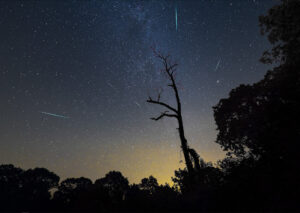By Jett Peters

Each year on August 11-13, the Perseids meteor shower is at its peak. Perseids is one of the most spectacular and well-known celestial events. The Perseids are named after the constellation Perseus, from which they appear to radiate, though they can be seen across the entire night sky in somewhat lower concentrations. For astrophotographers the coordinates are officially listed at right ascension 3h15m22s, and a declination of 58°09’23.8”, or right below the Heart and Soul Nebula.
The Perseids originate from the debris left behind by Comet Swift-Tuttle, which orbits the Sun every 133 years. The Perseids happens at the same time every year because of the mechanism that causes meteor showers. There are many misconceptions about meteors, but they are mainly caused by Earth passing through a region of debris on our orbit of the Sun. In this case, it is as Earth passes through the comet’s trail. Tiny particles, mostly the size of sand grains, enter our atmosphere at high speeds. These particles burn up due to friction with the atmosphere, creating bright streaks of light across the sky.
The Perseid meteor shower has been observed for at least 2,000 years, with records dating back to ancient China. It was officially recognized in the 19th century when astronomers connected the meteor shower to Comet Swift-Tuttle. Today, it is considered one of the most reliable meteor showers, producing up to 60 to 100 meteors per hour at its peak under ideal conditions. Some of these meteors are quite bright and can even be observed from highly light polluted areas. At the incredible sky condition at UDRO, the meteors will almost all be visible, and many should be caught on the all-sky camera.
Photographing the Perseids can lead to incredible time lapses or nightscape photos. The most important element is to have a wide field of view. While there is an official center of the shower, it is quite diffuse over the North-Eastern sky. Also, having a star tracker for this work can be helpful, as like any other object the center of the shower does move across the night sky at a sidereal rate. The meteors will appear as long streaks in your images, and many of them will have a green or reddish hue. Another interesting option is to capture the meteors while doing a star trails image. As the Perseid meteor shower is relatively close to Polaris, it is possible to capture the meteors along with the stars trailing around Polaris.
